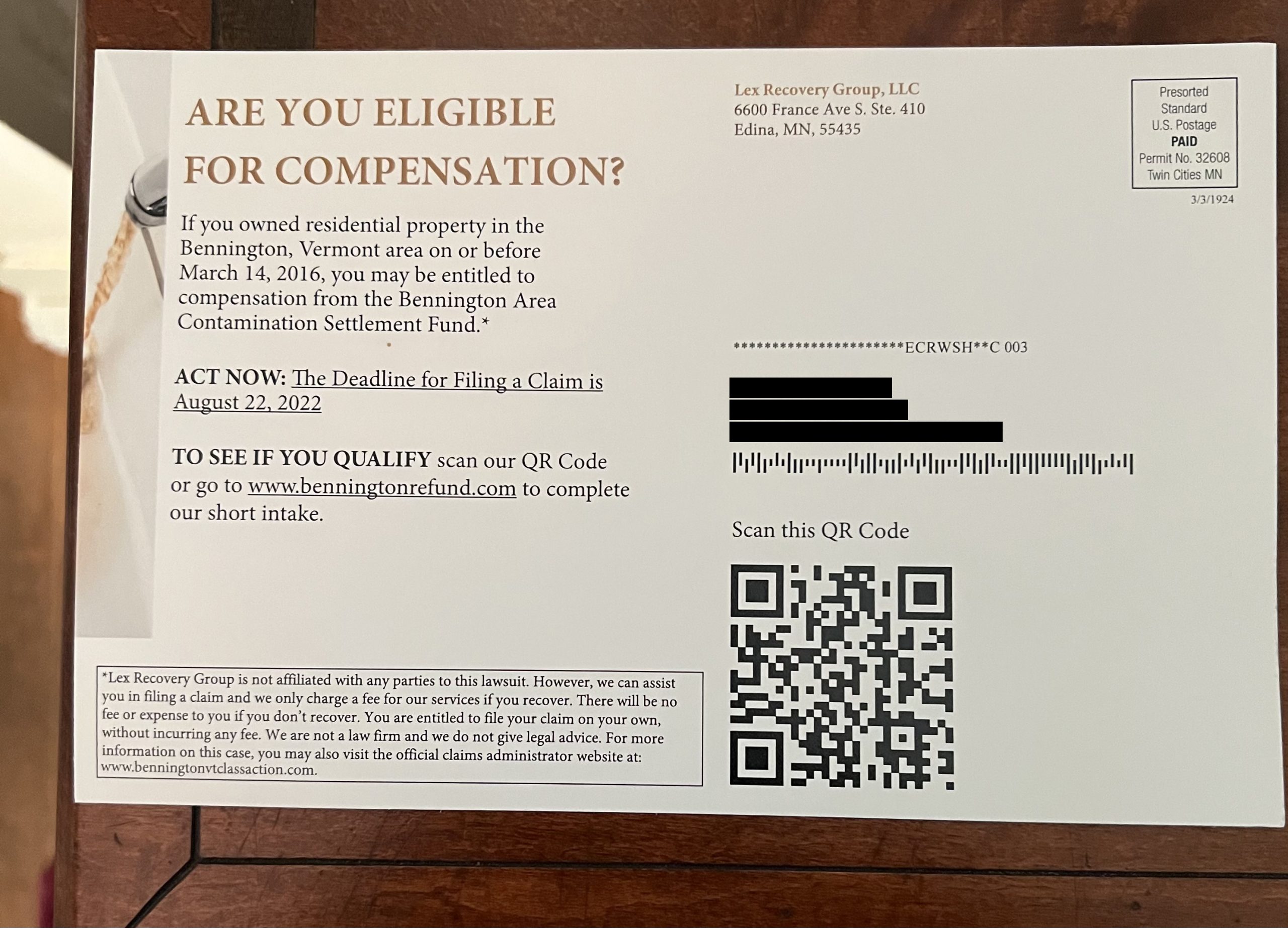
Hundreds of property owners in the Bennington area have already received money from a multimillion-dollar settlement in a chemical contamination case, their attorneys said.
But they also said the process has been disrupted by the entry of an out-of-state company that unnecessarily offered to help claimants for a fee.
As of early November, nearly 900 property owners had received checks from the class-action suit against multinational plastics company Saint-Gobain, said plaintiff attorney Emily Joselson. Her team hopes the 1,500 or so other eligible property owners in Bennington and Shaftsbury will get paid before the end of this year.
Once everyone has been paid, the plaintiff attorneys foresee a second round of checks being issued from what’s unclaimed in the $26.2 million settlement with property owners.
The payments are part of a recent $34 million settlement agreement in the federal court case, in which Bennington-area residents accused Saint-Gobain of contaminating their soil and water with emissions of PFOA, also known as perfluorooctanoic acid. The chemical had been used to coat fiberglass fabrics at the company’s now-shuttered factories in Bennington and North Bennington, previously owned by ChemFab.
In settling the case, Saint-Gobain denied the accusations and any wrongdoing.
Plaintiff attorneys said the process of reviewing and approving the property owners’ claims ran into problems with fraudulent claimants, as well as the appearance of Lex Recovery Group, a Minnesota company that offered to help beneficiaries file claims in exchange for a 25% cut of their compensation. They said those factors made the process more complicated and drawn out.


Plaintiff attorney David Silver said Lex Recovery offered its services through mass mailings to residents of Bennington and the village of North Bennington — including people who lived outside what is considered the zone of PFOA contamination.
“Their mailing did not indicate whether or not the resident was eligible, and implied that the resident was eligible,” Silver said. “So we received many claims from residents that were not eligible, and that, of course, took up a great deal of time to determine eligibility.”
Property owners are eligible to claim compensation if they meet the qualifications: They either owned residential real estate within the “zone of concern” as of March 14, 2016, or after that date bought property that was later added to the zone.
Plaintiff attorneys said they were on hand to help people file their claims — for no fee. Silver described the process as “relatively simple,” involving a valid property tax bill from 2016. He said his and Joselson’s Vermont law firms also assisted those in more complicated situations, such as a property owner who had died or owners who divorced.
“Lex charges 25% of the recovery for doing something that 90% of the claimants could do on their own easily, and the others could call us for our free assistance,” he said.
Joselson said their team was able to “intercept” some claimants who would otherwise have paid Lex a fee.
“We just are concerned that all eligible class members get what they’re entitled to,” she said, “and any efforts that reduce their recovery is of concern to us.”
Joselson said the payments to property owners varied, based on factors such as the size of their property and its water source. For instance, she said, $1,000 would go to the owner of an undeveloped vacant lot with no access to water, while at least $100,000 would be designated for larger houses with highly contaminated properties.
Lex Recovery Group, which describes itself as an “outsource solution in class action recoveries,” didn’t respond to VTDigger’s multiple requests for comment.
Before the deadline for filing claims closed in August, the Vermont Attorney General’s Office reminded potential beneficiaries that they didn’t need to pay a fee to make a claim. Now, the office said, Vermonters who didn’t receive the service they paid for or are not satisfied with the service they received can file a complaint with the state’s Consumer Assistance Program.
Also under the court settlement, up to $6 million will be used to establish a free medical-monitoring program, which Joselson said is expected to start in the first three months of 2023.
The program aims to screen for certain diseases among residents who were exposed to PFOA, a variant of the PFAS group of chemicals that has been linked to health problems.
The monitoring service will be available to residents who ingested PFOA-contaminated water and who have more than 2.1 parts per billion of PFOA in their blood. The median blood concentration of PFOA for the U.S. general population is 2.08 parts per billion, according to one study.
The 15-year monitoring program will be run by Southwestern Vermont Medical Center, the hospital in Bennington. Beneficiaries who now live more than 50 miles away can participate in the monitoring remotely.
Right now, potential beneficiaries are undergoing blood tests to determine whether they qualify for the program. Joselson said that, if they have not already done so, people who have received notice should immediately set up a blood test appointment before this phase ends.
“There will eventually come a time when they will no longer be eligible,” she said. “They should make their appointments as soon as possible.”
More information on the case settlement is available at benningtonvtclassaction.com.
